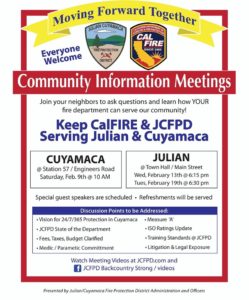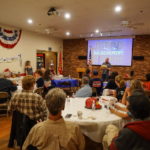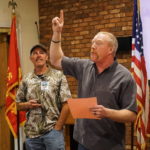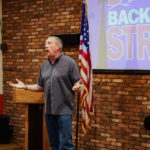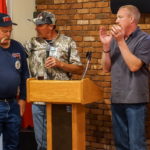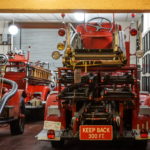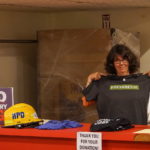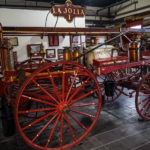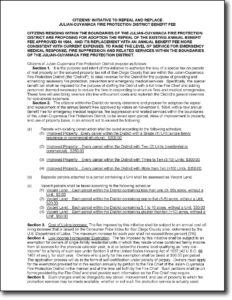This is a DEMAND TO CEASE AND DESIST letter from Procopio Law to Mr. Heinlein and Mr. Reddick. Again they are not working with the parties but are continuing to ignoring the law.
Cease and Desist Letter to County Counsel and SDCFA
Moonlight Fire Litigation- A story of Calfire corruption.
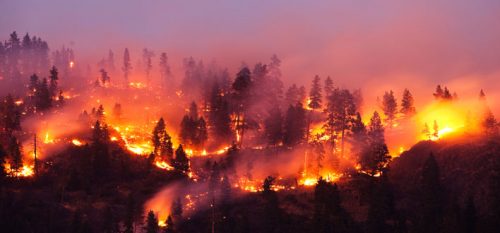
Article by Paul Kruze, Contributing Editor at East County Magazine

Dateline: 04/25/2019
Today in court JCFPD reached a 30-day agreement with the County that allows for JCFPD personnel to remain at Station 56 and requires both parties to exchange certain information so that there is a clear understanding of the status of public assets. The parties and the court will re-evaluate the agreement as it gets near the end of the 30-day period.
In the meantime, the court has asked all parties and supporters to tone down their rhetoric while the matter makes its way through the judicial process. JCFPD has confidence in the process and makes the same request.
Filed by the Attorney for the JCFPD Board, Cory Briggs on Thursday 04-18-2019-
Large file 399 pages- 12.8 MB
JCFPD’s Opp_Br-CASE NO. 37-2018-00020015-CU-WM-CTL
SNOWED IN SAN DIEGO!!!!! JCFPD responding to the call like a BOSS!
Shout out to our JCFPD today with all this crazy snow. Responding where others can’t. We got this. #LIKEABOSS
Posted by Discover Julian on Thursday, February 21, 2019
Below was filed by the lawyer for the Fire Fighter Association on April 12, 2019:
Julian Fire Association files this response to the ex parte application and the oppositions of County of San Diego (“County”) and San Diego Local Agency Formation Commission (“LAFCO”) because they both make inflammatory and unsupported statements that are not supported by fact or law.
Julian FFA Response to Ex Parte Application 4-12-19
A message to our family, friends, and neighbors in the Julian-Cuyamaca community, throughout California, and across the United States:
The men and women of the Julian-Cuyamaca Fire Protection District are facing an illegal government takeover of our volunteer fire department — San Diego County’s last volunteer department — and that’s putting the public at risk.
Throughout our history, JCFPD has been responding to emergency calls in our community: heart attacks, car crashes, wildfires, you name it. More than 60 members strong, we proudly serve everyone in the community — whether local or visitor, young or old, rich or poor, regardless of culture or creed. We are woven into the community’s fabric and remain in the station ready to serve in the event of an emergency.
Legal documents and bureaucrats call this place a “special district.” We call it “home.”
Normally we’d be waiting here in the station until someone calls in need of help. Our history has always been responding to calls for help. But today is different.
Today we are asking you for help. Today we are the ones who desperately need your help.
We were formed years ago by this very community because everyone knows, in our remote part of the county, that local knowledge of the area means getting to each emergency faster than any outsider could. Our knowledge can literally mean the difference between life and death.
Unfortunately and inexplicably, the county government has placed this community at grave risk by illegally “dissolving” our department and handing over all fire and EMS responsibilities to a state bureaucracy. Our lawyer (Cory Briggs) informed the county that finishing the dissolution process would be illegal because a judge had ruled three days earlier that the decision to start the process was “null and void.” Yet within minutes of ignoring the judge’s ruling and declaring our department dissolved on paper, the county sent armed sheriff deputies in body armor to forcibly remove us from the stations. They broke through a window at one station and took it over.
We have locked ourselves in the remaining station not in protest or defiance, but in order to ensure that the people who can best respond to an emergency are here to do so when the call comes. We have the training, experience, facilities, and equipment to keep our community safe. The county bureaucrats, and the state agency they are paying to take our place, do not.
We are peaceful. We are not armed. We wish no harm to anyone. We will abide by the court’s rulings.
However, even though we have confidence that our lawyer is doing the best he can under the circumstances, we do not have full faith in the legal system. The county has an army of lawyers. County officials have knowingly pushed the dissolution process forward even though they knew there was a legal challenge to the decision to start the process. Nobody at the county cared. They decided to take control over the department and its money long ago, no matter how that legal challenge ended and no matter how poorly served the community would be with us gone. And when they were not distorting existing rules to their advantage, those officials were literally writing new one-sided rules to hurt us.
Yes, the community won the first legal battle. But county officials continue to manipulate the legal system; their lawyers call us “the crazy people at the Julian FD.” In the end, we might not win this war.
So while we are hopeful that justice will eventually be done in the courtroom next Wednesday, we cannot be confident. The best chance for our community to prevail against this hostile government takeover is for you to contact all five county supervisors — right away, please — and tell them that you #StandWithJCFPD.
Every one of us has pledged to protect this community. But after last Monday’s vote to complete the illegal dissolution, the county indicated that we no longer have legal protections as firefighters and paramedics.
What if there is a car crash with injuries or a house catches on fire? According to the county, we have no legal right to respond. By using the department’s equipment and vehicles, we could be prosecuted for vandalism or theft. By performing CPR, we could be prosecuted for assault and battery. By putting out a fire started suspiciously, we could be prosecuted for interfering with a crime-scene investigation. The county has put us in the gut-wrenching position of having to decide between losing our life’s savings and our freedom versus coming to the aid of people needing emergency assistance. What kind of a government does that to constituents and first-responders?
If you think that prosecution isn’t a real threat, remember that the district attorney is an elected official just like the county supervisors and was their chosen successor to the previous district attorney when she retired. And despite all the local news coverage, the new district attorney has not called our fire chief or our lawyer to assure us that we remain free to help if the need arises. In fact, the station we occupy is under law-enforcement surveillance around the clock.
Below is the contact information for all five county supervisors. Please contact them and tell them two things: that you stand with JCFPD, and that you want the dissolution undone immediately. The politicians have the power to turn back the clock. If they hear from enough of you, we think they will do the right thing. But they are incapable of finding either courage or urgency without a groundswell of public outcry the likes of which they’ve never seen.
We also have a message for the law-enforcement personnel assigned to monitor the station we occupy: We know you disagree with the assignment. Like the broader community, you too are our brothers and sisters. Like us, you took an oath to protect and serve. We have seen each other many times in the field, worked with each other countless times, responding to community emergencies. We know you are only doing your jobs, that you have to follow orders. We harbor no ill-will toward you. We are eager to get back to our regular duties, working side by side with you protecting and serving the public when crisis arises.
Here is the contact information for the five county supervisors. Thank you for standing with us.
BOARD OF SUPERVISORS
Supervisor Greg Cox
greg.cox@sdcounty.ca.gov
Phone: 619-531-5511
Twitter: @supervisorcox
Supervisor Dianne Jacob
dianne.jacob@sdcounty.ca.gov
Phone: 619-531-5522
Twitter: @dianne_jacob
Supervisor Kristin Gaspar
kristin.gaspar@sdcounty.ca.gov
Phone: 619-531-5533
Twitter: @kristindgaspar
Supervisor Nathan Fletcher
Nathan.Fletcher@sdcounty.ca.gov
Phone: 619-531-5544
Twitter: @supfletcher
Supervisor Jim Desmond
Jim.Desmond@sdcounty.ca.gov
Phone: 619-531-5555
Twitter: @jim_desmond
Julian & Cuyamaca Residents
Please come to one of these informational community meetings:
* February 9th Saturday 10:00 at Lake Cuyamaca Volunteer Fire Station
* February 13th Wednesday 6:15pm at the Julian Town Hall
* February 19th Tuesday 6:30pm at the Julian Town Hall
Chief VanBibber and your Local Volunteers will be happy to answer your questions about JCFPD.

Measure A Flyer
This is worth posting again to let the community know how Riverside County Fire services are escalating with Calfire. This is really very troubling, because this is the same model they want to use for San Diego!
RIVERSIDE COUNTY FIRE DEPARTMENT
FY 17-18 SERVICE ALTERNATIVES
MARCH 7, 2017
This is a letter the JCFPD Board and others received from some citizens of Julian/Cuyamaca
This letter is to inform the San Diego County Board of Supervisors and LAFCO that:
We the citizens of the Julian Cuyamaca Fire Protection (JCFPD) district in support of an independent fire protection district will be asking the JCFPD Board of Directors to rescind the application to LAFCO on Dissolution. We are asking for this due to the numerous violations of the Brown Act by the board, the false and misleading statements included in the application to LAFCO, the secrecy of the process- keeping the public and board members uninformed about negotiations and process and the pending litigation against the JCFPD Board for their actions which need to be resolved before moving forward.
We will also be asking for a Grand Jury to investigate this whole process.
To the good citizens of Julian and Cuyamaca,
There has been some confusing information floating around about the status of the Julian Cuyamaca Fire Protection District (JCFPD) and its future. Let us clarify a few things for you. JCFPD is certainly going through some growing pains, a transitional period if you will. This stems from several past administrations, who, although very frugal with our tax dollars, failed to plan into the future. We assure you we are not broke or broken as has been portrayed. The fact of the matter is, JCFPD needs three facets to be successful. A supportive fire board, the leadership of a fire chief who understands our communities needs, and a community that stands behind their fire department. With these things, we can and will deliver better services than what is offered by the San Diego County Fire Authority (SDCFA) plus, you the citizens of Julian and Cuyamaca maintain oversight and control of your fire department.
A new fire board and fire chief are in the works and will be in place after the November elections. Thus, two out of the three facets will be met. The third facet is all of you and the continuing support you have always provided. In fact, it was the citizens of our community in conjunction with non-paid members of the fire department who placed on the ballot a measure (Proposition QQ) that would increase our working budget to allow us to meet and even exceed the current fire service industry standard. After all, how many of us can function today on a budget intended for 1984?
Proposition QQ repeals the original $50.00 per year assessment and replaces it with a $200.00 per year assessment. There truly is no down side to Prop QQ. We need to pay one way or another for fire services here in our community. The $50.00 we have been paying is no longer enough to sustain a fire department. No fire department in the country that could run on what JCFPD has been running on for 34 years. This intended fee cannot be increased in the future without voter approval unlike the County who can impose fees at any time.
Prop QQ allows us to keep both JCFPD and Cal Fire on the hill to fight fires. JCFPD will continue to be responsible for structure fires, traffic collisions and medical calls. Cal Fire will continue to be here to fight wildfires. Remember Cal Fire’s responsibility has been and will continue to be to fight wildfires in the SRA (State Responsibility Areas of California).
Provisions have been put in place in Prop QQ to ensure if JCFPD ever dissolves the citizens WILL NOT have to continue paying the $200.00. Unfortunately, because of the way the current fire fee initiative was written back in 1984, we will be required to continue to pay the $50.00 and it would get rolled over to SDCFA. To be clear, the $50.00 fee would continue on top of the additional fees SDCFA will be charging the citizens of Julian and Lake Cuyamaca. Currently, citizens in Riverside County are paying a $400.00 per year subscription fee, plus $390.00 per hour usage fee for emergency fire services contracted to Cal Fire.
QQ has a built in a low-income provision which allows, for those who qualify, to continue to pay only the current $50.00 per year fee.
The $200.00 per year ($17.00 per month) in Proposition QQ will get you more than what SDCFA is promising (one fire engine and two firefighters with the closest help over 30 minutes away) This is not a fire department. With the increase in fees, JCFPD will become a hybrid (combination, paid and volunteer) station, such as the Idyllwild Fire Dept. It will no longer be completely volunteer. JCFPD will provide two paid firefighters (one of which will also be a paramedic) on a fire engine 24 hours a day, 7 days a week. It will also cover the Cuyamaca station. It will provide a full-time fire chief, administrative support, plus a brush engine, rescue unit, water tender and an on-duty battalion chief. The JCFPD paid personnel on the fire engine supported by on duty volunteers, will stay in our district (as they did during the Cedar, the Witch and countless other fires) and will not go off the hill to fight fire in another community, as Cal Fire frequently does.
This is our fire department and our personnel serving our communities, not big government. It is your family, friends and neighbors in service to each other. It is a small slice of Americana that continues to make Julian and Cuyamaca a wonderful place to call home. And, for those who come to visit, one of many reasons to come back.
We encourage all of you to vote YES on Proposition QQ and support YOUR local fire department.
Written by: The Julian and Cuyamaca Citizens Committee to promote honesty and responsibility in government.
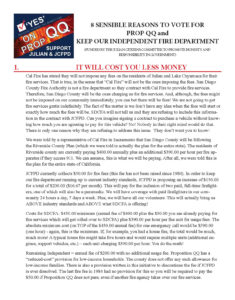 8 Reason for JCFPD to stay independent
8 Reason for JCFPD to stay independent
1. IT WILL COST YOU LESS MONEY
Cal Fire has stated they will not impose any fees on the residents of Julian and Lake Cuyamaca for their fire services. That is true, in the sense that “Cal Fire” will not be the ones imposing the fees. San Diego County Fire Authority is not a fire department so they contract with Cal Fire to provide fire services. Therefore, San Diego County will be the ones charging us for fire services. And, although, the fees might not be imposed on our community immediately, you can bet there will be fees! We are not going to get fire services gratis indefinitely. The fact of the matter is we don’t have any idea when the fees will start or exactly how much the fees will be. SDCFA will not tell us and they are refusing to include this information in the contract with JCFPD. Can you imagine signing a contract to purchase a vehicle without knowing how much you are agreeing to pay for this vehicle? No! Nobody in their right mind would do that. There is only one reason why they are refusing to address this issue. They don’t want you to know!
We were told by a representative of Cal Fire in Sacramento that San Diego County will be following the Riverside County Plan (which we were told is actually the plan for the entire state).
The residents of Riverside county are currently paying $400.00 annually plus an additional $390.00 per hour per fire apparatus if they access 911. We can assume, this is what we will be paying. After all, we were told this is the plan for the entire state of California.
JCFPD currently collects $50.00 for fire fees (this fee has not been raised since 1984). In order to keep our fire department running up to current industry standards, JCFPD is proposing an increase of $150.00 for a total of $200.00 ($16.67 per month). This will pay for the inclusion of two paid, full-time firefighters, one of which will also be a paramedic. We will have coverage with paid firefighters in our community 24 hours a day, 7 days a week. Plus, we will have all our volunteers. This will actually bring us ABOVE industry standards and ABOVE what SDCFA is offering!
Costs for SDCFA- $450.00 minimum (annual fee of $400.00 plus the $50.00 you are already paying for fire services which will get rolled over to SDCFA) plus $390.00 per hour per fire unit for usage fees. The absolute minimum cost (on TOP of the $450.00 annual fee) for one emergency call would be $390.00 (one hour) – again, this is the minimum. If, for example, you had a house fire, the total would be much, much more! A typical house fire might take five hours and would require multiple units (additional engines, support vehicles, etc.) – each unit charging $390.00 per hour. You do the math!
Remaining Independent = annual fee of $200.00 with no additional usage fee. Proposition QQ has a “reduced-cost” provision for low-income households. The county does not offer any such allowance for low-income families. There is also a provision written in this initiative to discontinue the fee if JCFPD is ever dissolved. The last fire fee in 1984 had no provision for this so you will be required to pay the $50.00 if Proposition QQ does not pass, even if another fire agency takes over our fire services.
2. YOU WILL NOT GET A SURPRISE INCREASE IN FEES
The county can increase fees if and when they deem it necessary. And, because it is a “fee” and not a “tax” you will not get a say in this. The additional $390.00 per hour usage fee was just recently imposed on residents in Riverside County to augment the annual $400.00 fee. Cal Fire stated they could no longer provide services within the old budget. There are agencies all across California (Calimesa, San Jacinto, Canyon Lake) that contracted with Cal Fire that are currently trying to get out of their contract because the cost of Cal Fire is going through the roof. How much and how often will fees increase? Cal Fire has recently admitted publically that the cost of their fire service are continuing to rise so there is no telling!
If we remain independent and JCFPD wants to raise the fees for the department it must go to the vote of the people (like we are doing this November with Proposition QQ). You will have a say!
3. YOU WILL GET MORE SERVICES FOR LESS DOLLARS
If we remain independent, we would continue to have two fire agencies in our community – Cal Fire and JCFPD. Cal Fire would still be here and they would continue to be responsible for wildfires. JCFPD would also be here and they would continue to be responsible for structure fires, traffic collisions and medical aids. The two agencies would continue to work cooperatively, side by side just as they have since the inception of JCFPD. And when Cal Fire is called off the hill, JCFPD will still be here, but now as your only line of defense, for wildfires.
Remaining independent means there are more firefighters here in Julian/Cuyamaca, not less. Getting rid of JCFPD drastically reduces both the number of fire engines (and other fire apparatus) and the number of firefighters in our community. If the county takes over, we lose all the volunteers (historically, there has been five volunteers on duty per day that respond with multiple vehicles – brush truck, fire truck, rescue unit, water tender, etc.). Under SDCFA/Cal Fire, all of our volunteers and all our equipment would be replaced with a single engine and two firefighters.
SDCFA (a minimum of $450.00) = no daily direct supervision of staff, no administrative support, two firefighters (that can leave our community to go to wildfires or to cover a more densely populated community). You will have no input on where your money goes. This would be decided by the County.
*A fire engine and two firefighters do not make a fire department!
Keeping JCFPD ($200.00) = a full-time fire chief, administrative support, a fire board, historically five volunteers per day, numerous fire vehicles, plus two paid firefighters (that will remain in our community 24-hours per day, 7 days a week). Plus, you will have a say in how things are run.
*This is a fire department!
4. YOU WILL HAVE FIRE/EMS COVERAGE WHEN CAL FIRE LEAVES THE HILL
When there are wildfires in the surrounding areas or when there are big wildfires elsewhere in California, Cal Fire is likely to leave our community to go to where the fires are. Fresh in our minds are two large fires in Julian – the 2003 (Cedar Fire) and 2007 (Witch Fire) in which our volunteers were the only ones left here to protect us and our property. So far, this fire season, during the Pala Fire (in June), the Cinnamon Fire (in July) and the San Pasqual Fire (in August), Cal Fire was gone. Without our volunteer fire department, you will have no fire protection at all when Cal Fire is off the hill. You will be on your own!
5. YOU WILL NOT HAVE STATIONS THAT ARE UNSTAFFED OR UNDERSTAFFED
Almost all of the fire agencies we have spoken to that have been absorbed by or that have contracted with SDCFA have been very dissatisfied with the level of service they are receiving. Fire stations in these communities have been left unstaffed/dark (anywhere from 1 to 27 days of the month) or have been significantly understaffed (less than two trained firefighters on duty).
Last year in Shelter Valley there was a house fire. The personnel Cal Fire placed at the station that day was not trained to drive a fire engine. So, wanting to do something to help, one of the firefighters decided to run to the fire with a fire extinguisher. As you can probably guess, this did nothing to suppress the fire. The house burned to the ground and the residents suffered bodily injuries.
6. YOU WILL HAVE FIRE PERSONNEL RESPONDING THAT ARE FAMILIAR WITH THE AREA, TERRAIN AND WEATHER CONDITIONS
In a true emergency, minutes can mean the difference between life and death or whether your home is saved or burnt to the ground. Most of the contracted Cal Fire staff that are stationed here in Julian/Cuyamaca are unfamiliar with the area and have had difficulties finding addresses. Additionally, their fire engines are not equipped to get up the steep, tight driveways many of our homes have. Our volunteers know the area well and the fire engine purchased for JCFPD was specifically designed to be driven in our unique mountain terrain. Our local volunteers are your neighbors, friends and/or family. They are accustomed to driving in dense fog, snow and ice and they know how to find you!
7. YOU WILL HAVE A SAY IN HOW YOUR FIRE DEPARTMENT IS RUN
If SDCFA takes over our fire department, the decisions that affect our community will be made some 60 plus miles away and you will have no say in what transpires. If our community is unhappy with these decisions, we have absolutely no recourse. Remain independent and we, the citizens, maintain oversight of our fire services.
Unlike San Miguel (who wisely wrote a contingency plan in their agreement with SDCFA), we cannot take our fire department back (like San Miguel did because of increasing costs and poor service from Cal Fire) or contract out to another agency. In the “negotiations”, our fire board turned everything over to the county (our money, our fire station, our property in Lake Cuyamaca, our vehicles, our equipment – everything!). Which means once our fire department is gone, it is gone! There IS NO going back! We have no alternative if the county does not live up to their promises. Most communities with SDCFA are extremely dissatisfied and they are absolutely powerless to do anything about it. They have begged and pleaded with SDCFA to live up to their promises to protect their homes and their lives – to no avail!
8. YOU ARE NOT TAKING THE RISK OF BEING LEFT WITH ZERO FIRE SERVICES
Fire protection is not in San Diego County’s Charter. So even though we would contract with them to provide fire protection, they are not legally bound to do so (not much of a “contract”). If they run out of money (which is a definite possibility), they could discontinue providing fire protection (that is exactly what happened in 1973 when we lost our fire department) and our community would be left (once again) with nothing and no one to protect us (remember, we are giving away all of our assets – everything – over six-million dollars’ worth!)
** For verification of the above information:
simply google Cal Fire costs/fees, etc.
or go to or view below:
https://www.youtube.com/watch?v=dtiEovX1Wpg
CASSIE MacDUFF: County putting the squeeze on contract cities
https://patch.com/california/lakeelsinore-wildomar/riverside-county-fire-departments-rising-costs-will-be-shared
http://www.badlandsjournal.com/2018-06-01/008839
or
Check out the links to official documents at
www.jcfpd.com
www.julianfireplugs.org
www.backcountrystrong.org
And
Please, talk to the residents of Ranchita, Shelter Valley, Mount Laguna, Intermountain, Palomar Mountain, San Pasqual, Boulevard, San Miguel, Descanso and Pine Valley and get their input.
FFs Contributing More to CA Pension System
California firefighters are putting more into their pensions while the cities that employ them struggle to manage fast-rising retirement costs.
Protest Petitions to sign or circulate
Below are links for printing your own documents.
You can go here to check if you are registered to vote and your registered address. SD VOTE
HEAR and read OUR INTERVIEWS: JULIAN-CUYAMACA FIRE CHIEF, PARAMEDIC AND FIRE SURVIVOR SPEAK OUT
TO SAVE THEIR FIRE DEPARTMENT
Listen to the EAST COunty Magazine INterview
Vote YES on QQ! Save our JCFPD
“The community first spoke out in 2013 that we didn’t want to be part of the county fire authority. There is no reason why we (JCFPD) have to go away. There is no reason why we have to have one or the other. We can have both and we have for 35 years.” – Mike Van BibberSave our historic JCFPD. Vote yes on QQ. http://www.julianfiredept.com/
Posted by JCFPD Backcountry Strong on Thursday, September 27, 2018
Look for your protest ballot in the mail!
Please sign and return,
showing that the democratic process works.
Also learn about the initiative QQ and vote YES on this ballot item to support JCFPD into the future!
NEWS HEADLINES
LAFCO Votes to End Julian Volunteer Fire Dept.,
Invites Town to Save It
Article by Ken Stone
JULIAN RESIDENTS AGAINST COUNTY TAKEOVER OF FIRE SERVICES WIN VICTORY IN COURT, BUT SETBACK AT LAFCO HEARING
Article from EAST COUNTY MAGAZINE
California fires: Over 5 days, requests for 900 engines went unfilled
Article from SF Chronicle
CAL FIRE NEEDS $234M BEFORE FALL FIRE SEASON
From NBC San Diego
CAL FIRE ALMOST OUT OF MONEY, AGENCY SAYS
From 10 News San Diego
JCFPD Has Not Dissolved Yet
Article from Julian Times Online
Our View: Volunteer firefighters worth their weight in gold
Article from Times Leader
This is a email received from a JCFPD Supporter.
Thanks for the information. I personally never want to relive 2003 and this is why I feel it is in both the town & county’s interests to retain Julian-Cuyamaca Fire in addition to the Cal Fire resources. We need all the protection we can get and that is definitely not happening for Ranchita, Warner Springs, Shelter Valley or Julian proper under Cal Fire’s plan. Relying solely on Sacramento in a wildfire crisis costs lives, properties and a whole plethora of economic/legal issues we’re still recovering from today. The FD relies on local knowledge, training and experience to be even moderately effective during a typical fire season. We’ve had this argument over 30 years and seen how badly things can fall apart once the State takes over… As someone pointed out, nothing in CalFire’s statement is guaranteed. The language in that ‘plan’ is mostly fear mongering propaganda. We are already dealing with huge shortages in basic emergency services (including law enforcement) as it is. Two homes were lost to fire in Shelter Valley due to poor response, not to mention the string of break-ins and thefts going mostly unreported and uninvestigated. Your local tax dollars pay for these services, ergo the politicians and advisory boards must be accountable to you, the taxpayers. Never miss a chance to remind the government who it works for!
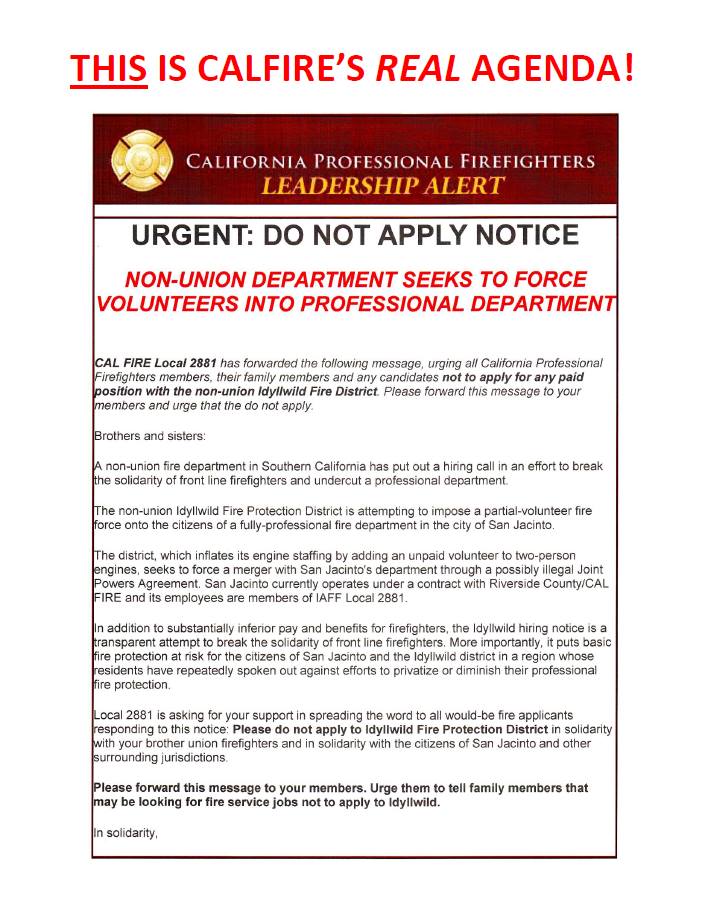 This is a comment from FB from someone who has been through the takeover process with Calfire:
This is a comment from FB from someone who has been through the takeover process with Calfire:
Ken Rice- In writing exactly the double speak or forked tongue the Indians spoke of pure politics .As a member of the San Diego county fire authority saw this first hand ,the great firefighters I served with told me how most started as volunteers as did their uncles brothers and grandfather.But now union won’t even let us ride on the same engines ,if the union could its way it would take from the Girl Scouts in my opinion.Sad to see the great profession of firefighters being self destructive.If the union gets what it wants they will have to lay off firefighters when they run out of ways to fund and rural areas will be on there own again like they did in late 70s .
This is a response letter from the State of CA to the JCFPD Board about the “Vote of NO Confidence” presented to the board on November 14, 2017:
Julian Volunteer Fire Company Association v. Julian-Cuyamaca Fire Protection District
Unfair Practice Charge No. LA-CE-1281-M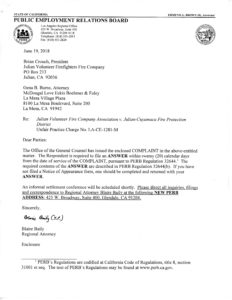 PERB Public Employees Relations Board letter
PERB Public Employees Relations Board letter
https://www.perb.ca.gov/
2018 Fundraiser at the Firehouse Museum in San Diego
was a huge success and a wonderful time was had by all.
Tensions Flare in Julian as Popular Fire Battalion Chief Put on Leave

Julian Firefight: New Chief Faces Lawsuits, Protests over County ‘Hostile Takeover’
Want to talk to him:
Jeremi Roesler
619-820-1542
jeremi.roesler@fire.ca.gov
CAL FIRE Wins Dishonor of the California Golden Fleece® Award
Golden Fleece Award_ Independent Institute – PDF of above article
Moonlight Fire Litigation
On Labor Day, September 3, 2007, a wildland fire broke out on private property in Plumas County. Dubbed the “Moonlight Fire” because of its proximity to Moonlight Peak, it ultimately burned 65,000 acres, including 45,000 acres of federal forest land.

CITIZENS’ INITIATIVE TO REPEAL AND REPLACE
JULIAN-CUYAMACA FIRE PROTECTION DISTRICT BENEFIT FEE
IS NOW ON THE BALLOT IN NOVEMBER!
We will be getting the word out and educating the community on this. Please read the initiative. an if you have any questions contact us and we will give you the answers if we have them.
Here are a couple of good articles about Fire Departments who have to go a different route than Calfire because the cost of Calfire is too much and still growing.
County putting the squeeze on contract cities
Calimesa selects its in-house fire department

Must read if you want a vision of the future for San Diego CO.
Riverside County Cost recovery plan
Special Board Meeting called by Board Pres. to address Brown Act violations, scheduled for April 5th @ 9am.
April 5th, 2018 @ 9 am, at the Julian Fire Station # 56 will be a Board Meeting to address the Brown Act violations set forth in the below document. Please read the below doc then come to learn about how the board is run.
Brown Act Demand for Cure and Unconditional Commitment to Cease and Desist
California Burning: CAL FIRE Wins Dishonor of the California Golden Fleece® Award
California Burning: CAL FIRE Wins Dishonor of the California Golden Fleece® Award
The California Department of Forestry and Fire Protection (CAL FIRE) has won the Independent Institute’s California Golden Fleece®Award, given out quarterly to state or local agencies or government projects that break the public trust, and even swindle taxpayers.
CAL FIRE—whose primary responsibilities are fire prevention, suppression, and safety in the 31 million acres of California land that are designated State Responsibility Areas (SRA)—favors expensive and inefficient fire management strategies that increase its budget but put people and property at greater fire risk. CAL FIRE also benefits from a controversial “fee” that was adopted by the California legislature in a manner that violated the California Constitution.
The agency has also been plagued with multiple scandals. And its inability (or desire, in some cases) to rein in these troubling problems does not inspire confidence.
CAL FIRE’s poor handling of fire safety and costs, severe lack of accountability to taxpayers and landowners, and numerous scandals make it a hindrance to the state. Fixing these problems now requires divesting responsibilities from the agency and empowering private landowners.
Background
CAL FIRE’s origins go back to 1885, when the California State Legislature established the State Board of Forestry. The board’s duties at the time were relatively limited: it had authorization to handle information relating to forestry, and it enforced the small number of laws that had been enacted regarding brush and forest lands. The agency was short-lived, however, and was abolished just eight years after it was created.
At the turn of the century, a new Board of Forestry was created along with the position of State Forester, which set the foundation for what would become the California Department of Forestry and Fire Protection, or CAL FIRE. According to its official history, this early incarnation of CAL FIRE consisted, for almost 15 years, of only the State Forester, a small office staff, and a collection of local fire wardens. The state did not fund a wildfire protection force.
That began to change in 1919, when the state began to allocate money for fire prevention and suppression, CAL FIRE’s current mandate. In the years that followed, the agency’s budget grew, along with its personnel and jurisdiction. Today, CAL FIRE assumes the primary responsibilities of fire prevention, suppression, and safety in the areas that are designated the State Responsibility Area (SRA).
The SRA is the land for which the State of California has primary financial responsibility when it comes to wildfire management. In total, it covers more than 31 million acres, and includes land that is privately owned, state owned, watershed, and rangeland. It excludes federally owned land, as well as land that falls within city boundaries.
In recent years, CAL FIRE has been charged with a tremendously important task, as drought and a beetle infestation have increased dead trees and raised fire risks in the state, and numerous wildfires have ravaged property and taken lives. Even this winter’s heavy rainfall could increase future fire risks in some parts of California as rain gives life to new vegetation thus generating extra fuel for burning during future fire seasons. Given these conditions, CAL FIRE’s failures have become more apparent and the need for change more urgent.
CAL FIRE Gets Failing Grade: Misguided Priorities, Poor Performance, and Increasing Budgets
CAL FIRE is the state’s second-largest recipient of budget funds among resource departments, behind only the Department of Water Resources. As the California Legislative Analyst’s Office reports in its breakdown of the proposed 2016–17 fiscal year budget, CAL FIRE stands to receive nearly $2.2 billion— an increase of almost 12 percent over the estimated budget for the previous year, and a 42 percent increase over its allocation for the 2014–15 fiscal year. Of this, about $1.8 billion is allocated toward fighting fires. The agency has become increasingly expensive for California taxpayers, a product of its misguided priorities.
CAL FIRE’s priority has been fire suppression, rather than prevention, and the budget bears this out. The proposed allocation to the SRA Fire Prevention Fund (SRAFPF)—which pays for efforts to reduce hazardous fuels (like dead trees and vegetation), provide fire prevention education, and plan fire prevention—is 5 percent smaller than estimated for the previous year. Of the $76 million proposed to the SRAFPF, only about $16 million are being made available in grants for local fire-prevention efforts.
Why the neglect for fire prevention? Ryan Yonk, a research fellow at the Independent Institute, and Devin Stein, a research associate at Strata Policy, explain that fire managers “face an incentive to focus on suppression where the budgets are larger, the risks are lower, and the very act of suppressing wildfires is much more heroic than chopping dead trees and conducting prescribed burns.” This problem plagues CAL FIRE as well as the U.S. Forest Service. This incentive has taken a heavy toll on fire prevention, which has proven to be superior to fire suppression at containing costs and damage once a major fire begins. Just consider the destruction wreaked on California in 2016.
CAL FIRE reports that in 2016 there were 5,762 wildfires in the SRA and contracted Local Responsibility Area, about 600 fires more than in 2015 and about one thousand more fires than the five-year annual average. Collectively they burned nearly 150,000 acres. This follows the very destructive fires of 2015, which burned 307,598 acres and brought the third most damaging wildfire in the state’s recorded history, the Valley Fire, which burned more than 75,000 acres of land in Lake, Napa, and Sonoma Counties, destroyed nearly 2,000 structures, and took four lives.
It is troubling, given these outcomes, that CAL FIRE’s priority remains fire suppression rather than prevention. The costs associated with fighting fires are high and have varied greatly, especially over the past 10 fiscal years. The 2010–11 fiscal year, for example, saw $90 million in suppression expenditures, whereas expenditures in the 2007–08 fiscal year were nearly six times that amount ($524 million). Fire suppression remains a costly priority for the state, the lack of glamor associated with prevention notwithstanding.
Who is tasked with clearing brush and creating fire-containment lines?
Nearly all firefighters tasked with this job are extremely low-paid volunteer prisoners from state and select county jails, working as part of the California Department of Corrections and Rehabilitation Conservation Camp program (“Fire Camp”). For their work, they typically get paid $2 per day and receive “time served” credit of up to two additional days per day worked. Pay gets bumped up to $2 per hour when fighting a fire. In 2015, up to 40 percent of firefighters battling California wildfires were inmates. But, even though these fire camps provide cheap fire-prevention labor for CAL FIRE, in recent years even this has proven unsustainable.
The 2011 “realignment” mandate (Assembly Bill [AB] 109 and AB 117), which sought to reduce the state prison population by moving “low-level” prisoners to county jails, has reduced the number of prisoners eligible for Fire Camp. About one-tenth of the budgeted positions for inmates have remained unfilled each year. In order to make up for the shortfall, CAL FIRE has turned to the much-higher-paid civilian workers from the California Conservation Corps (CCC) to do what work they can, given their minimal training and experience
Regarding the use of CCC workers to replace inmates, CAL FIRE spokesman Daniel Berlant told the Los Angeles Times: “In our eyes there’s no difference in the work force.” One notable difference, however, is that civilian workers must legally be paid at least five times more per hour of labor as most inmate fire workers make in an entire day, all for the same unglamorous work that CAL FIRE continues to deprioritize.
CAL FIRE’s increasing neglect of fire prevention has been costly and disastrous for Californians.
CAL FIRE’s Unconstitutional $100 Million Annual “Fee”
In order to help fund fire-management operations, in 2011 California Governor Jerry Brown approved a controversial “fee” on hundreds of thousands of property owners within the SRA. The formal cost to property owners is approximately $117 to $152 per year for each habitable structure, depending on whether or not it also falls within the boundaries of a local fire-protection agency. But the actual costs are much greater, and they affect more than 800,000 Californians who are responsible for payment.
The bill that established this revenue source (AB 29) passed in both the California State Assembly and Senate with no Republican support and with almost all Democrats in support. Importantly, it also failed to reach the two-thirds vote in each house of the legislature as required by the state constitution to approve new taxes or tax increases. By calling it a fee, proponents were able to deceptively overcome this important hurdle that would otherwise protect California taxpayers.
In 2012, the Howard Jarvis Taxpayers Association filed a class action lawsuit, challenging the validity of the “fee” and seeking a refund for all money paid. The purported fee, it argued, fits the exact definition of a tax as outlined in the constitution, and fails to meet any of the criteria that would exempt it from the twothirds legislative vote requirement. Specifically, they noted that money collected is uniform in amount (despite a large diversity in the character and use of taxed structures, as well as their fire risk and required fire services), and it provides a benefit to the public at large—making the purported fee “neither service-based nor proportional as required for a levy to be deemed an exempt ‘fee’ rather than a ‘tax.’”
The association’s filing notes that even Governor Brown seemed to question the bill’s constitutionality when he signed it, by directing the Department of Finance and CAL FIRE to work with the legislature to “identify necessary clean-up language to realize these revenues.” Since that time no such language clarifying the bill has been passed. Nevertheless, in the summer of 2012 the State Board of Equalization began collecting revenue for the 2011–12 fiscal year. And each year since then, the state has collected nearly $100 million from the tax.
Oddly, much of the money has been kept in reserves rather than being spent for prevention operations. A report by the Sacramento Bee in October of 2015 found that roughly 14 percent of revenue collected by then (about $43 million) sat in unused reserves. One supporter of the tax, Democratic Senator Darrell Steinberg, expressed his concern over the large reserve: “I just don’t want money sitting there when there’s a lot of prevention to be had and an increase in the number of fires. . . . You spend the reserves during the most crucial times.”
Of the revenue spent, nearly 10 percent (approximately $22 million) went to covering tax collection costs. Meanwhile, less than half that amount ($9.5 million) was made available for local grants, leaving many fire prevention projects in vulnerable areas unfunded. As the Bee’s report noted, these included projects “to remove flammable vegetation and dead trees from around the homes of low-income senior citizens and disabled residents.” In some cases where funds were approved, such as a Lake County project to create a second evacuation route, they were made available after fires had begun. Along with legal problems and revenue misallocation, the “fee” has caused perhaps an even worse problem: it has prevented local agencies from independently raising money for their own much needed fire-prevention efforts.
As of this writing (March 2017), plaintiffs in the lawsuit are waiting for the court to schedule a trial date. But even before a formal legal discovery process is completed, key facts about the so-called fee are clear. It was not approved in accordance with the California Constitution, and it has been especially costly for the communities that need fire prevention most.
Another Day, Another Scandal for CAL FIRE
CAL FIRE’s problems do not end with its poor operational performance, unsound budget priorities, or unconstitutional tax. The agency is also plagued by a culture of corruption and scandal, which slowly revealed itself after the brutal murder of 26-year-old Sarah Douglas in 2014 by her boyfriend, CAL FIRE battalion chief Orville “Moe” Fleming.
In the early hours of May 1, Douglas and Fleming got into an argument after Douglas came home from an evening at a local casino with her mother and sister. Fleming, who was 31 years older than Douglas, had been described as a jealous and controlling boyfriend. That particular night he was so enraged at Douglas—who had been preparing to leave him, according to family members—that he stabbed her to death and strangled her with a bed sheet. Douglas’s sister, who had been on the phone with Douglas when the argument began, discovered the gruesome murder scene the next day and alerted police. Fleming, meanwhile, went into hiding for the next 16 days.
Police eventually found Fleming, and upon arrest he confessed to the killing. Although he was ultimately found guilty of second-degree murder and sentenced to 16-years-to-life in a state prison, the drama did not end there. An investigation into the murder and Fleming’s relationship with Douglas led to the discovery of a web of corruption and abuse plaguing CAL FIRE and its firefighting academy in Ione, near Sacramento.
When police interviewed Fleming’s estranged wife, she told them that she had seen a video of Douglas having sex with other firefighters at the CAL FIRE Ione academy. Douglas, in fact, had previously worked as a prostitute and met Orville Fleming through a website advertising sexual services. Although the police did not find any evidence that would confirm the existence of such a video, what they found implicated numerous others. The nearly $2 million investigation revealed scandal after scandal.
Investigators discovered that at least one high-ranking official, CAL FIRE Assistant Chief Scott A. Henry, routinely used his work-issued cell phone and vehicle to connect and meet with prostitutes. Rather than terminate him, CAL FIRE retained Henry as an employee but demoted him to the role of battalion chief.
It was also discovered that another CAL FIRE employee, fire apparatus engineer Timothy L. Edgmon, was accused of drinking alcohol at a cadet graduation ceremony—in violation of official department policy—where he made unwanted graphic sexual advances on a woman, including publicly exposing his genitals and making thrusting gestures toward her. Edgmon maintained that it was a joke, but he was eventually fired in connection with the incident.
Another employee, fire captain Cole Pereira, similarly violated rules on drinking at least three times at department events, and allowed cadets to do the same, but was only temporarily demoted to the role of fire apparatus engineer.
Then came the revelation of a test cheating scandal at the Ione academy.
According to multiple sources, unethical measures were taken to ensure that cadets passed their exams— including manipulating scoring, tossing questions that too many cadets missed, and providing actual test questions and answers at Sunday-night “review” sessions the night before exams. The sharing of test materials is, of course, a violation of the cadet handbook, but according to former cadets the practice was widespread and well known.
The systematic cheating on basic skills tests meant that some firefighters could have been ill-prepared for their jobs, especially initially, putting themselves and the public at greater risk.
A 2015 state investigation into the cheating has also revealed suspect promotional practices and “inconsistent and contradictory” recordkeeping that obscures the reasons why firefighters punished for cheating were able to quickly regain their former rank.
California taxpayers deserve better conduct than this for their money.
The Pathologies of Government: A Lesson in the Economic and Human Costs of Government Bureaucracy
The problems with CAL FIRE are multifaceted, but they all stem from an over-reliance on government to solve problems better handled locally and by private citizens, where oversight would be stricter.
Consider the answer put forward by Governor Brown to clean up the Ione academy: $4 million to create a new unit focused on improving professional standards. This approach has taken the form of more paperwork and another bureaucratic layer to re-emphasize the principles and guidelines already in the existing CAL FIRE handbooks, its mission statement, and the agency’s code of conduct.
As Sacramento Bee reporter Jon Ortiz expressed in reaction to CAL FIRE’s approach to reform, “This is what state government does. It documents and trains and reminds, then trains and reminds and documents some more. It assumes that personnel problems stem from ignorance, not character.” CAL FIRE needs to clean house, but instead it will have more bureaucratic hires, staff meetings, and employee manuals on the horizon.
Ultimately, it should come as no surprise that CAL FIRE is unable to set proper operational priorities and contain costs, and has had to rely on a deceptive funding source. Many similar problems exist with the U.S. Forest Service, which handles fire prevention and suppression on federal lands.
A July 2016 report by the U.S. Department of Agriculture Office of the Inspector General paints a bleak picture of the U.S. Forest Service’s hazardous fuels reduction program. It found, among other problems, that the agency “lacks a consistent, cross-agency process for selecting its highest priority hazardous fuels reduction projects for completion,” that its method for tracking accomplishments led it to inaccurately report information to Congress, and that work hours charged by some units may not have actually been performed. Many of these same problems appeared in a 2006 audit, to no apparent effect.
Government firefighting agencies, both federal and state, have performed poorly. In each case, the priorities for government agencies are different than those of the citizens whose lives, money, and property are at stake.
The Recommendations:
Local Control, Private Ownership, and Accountability
Fixing CAL FIRE’s problems requires a bolder approach than merely creating a costly new commission to perform yet another oversight investigation. In fact, multiple investigations over time have exposed numerous problems that have only gotten worse. The problems are also deeper than personnel, and point to the need for more fundamental solutions.
Changing priorities
First, firefighting priorities need to change from strongly emphasizing active suppression to fuel reduction. This is because constant suppression of fires often preserves the growing quantity and density of fuels that will feed the next, potentially more dangerous fire—a cycle known as the “excess-fuels hypothesis.”
Controlled light fires and vegetation clearing efforts, thus, should be a higher priority where they can be conducted safely. They may not produce the same oversized budgets to CAL FIRE and glory to its firefighters as active suppression does, but these prevention efforts can help limit future costs, destruction, and loss of life.
This proposal, however, is not without risk of abuse. Claims about when various fire prevention strategies are warranted could be vulnerable to overstatement by CAL FIRE to maximize its budget. Not all fires are caused by excess fuels. The exaggeration of excess fuels could therefore become a method of increasing agency funding. There is also no guarantee that CAL FIRE would select the highest-priority fuel reduction strategies when needed or properly account for the related costs, an issue that mirrors several problems with the U.S. Forest Service’s fuels reduction program. Privatization of public land would help realign incentives for optimal fuel-reduction activities.
A need for less intervention
Along with a change in priorities there is need for a change in perspectives. Must firefighters (career or otherwise) always be the primary actors in fuel reduction?
The U.S. Forest Service has started piloting a policy that would let many naturally occurring, low-intensity wildfires burn. The move is expected to reduce the destructive potential of larger, more catastrophic fires in the future by clearing out dead trees and other fuels. Using computer modeling of terrain, it is possible to identify regions where such fires can safely burn without need for suppression. Also, firefighters can determine well ahead of time whether they are needed to intervene in order to protect people and property. This approach would save money currently being spent for active fire prevention and suppression, and it would increase safety.
According to University of California, Berkeley, fire scientist Scott Stephens, “If we continue to have that backlog of forests that are in terrible shape, I call that a freight train having a wreck.” Letting many of these naturally occurring, low-intensity fires burn would help clear the backlog.
An intelligent hands-off approach that extends to the SRA would pay dividends immediately. But what about land where fire threatens both lives and property? This question prompts the following reform.
Privatization of land and responsibilities
The boldest change that should be made is to shift responsibility for wildfire management entirely to local fire districts and property owners, where incentives to plan and execute effectively, efficiently, and safely are greatest.
Decentralizing wildfire management is not an entirely new idea. Proposals to delegate a larger role in funding, planning, and decision-making to local communities have been advanced with regard to the U.S. Forest Service. This policy would allow for expedited fuel removal, flexibility in planning, and the ability to waive federally mandated procedures and regulations. But fire threats on federal lands are not the only ones in need of greater local direction.
Ironically, localizing responsibility is consistent with the approach the Fire Prevention Fee is supposed to take.
Remember that, were it actually a fee and not a tax, property owners would be both the funders and only beneficiaries of firefighting services—and, importantly, benefits would be proportional to the amount each pays. Instead, the “fee” requires one state agency to collect money more or less uniformly from property owners on behalf of another state agency, and then requires local fire districts to apply for (and hope to receive) a portion of the available funds for their much-needed fire-prevention projects. Benefits are not proportional, which means that at least some property owners are clearly receiving less than they should, given their payments.
A better system allows property owners within local fire districts to develop priorities and direct fire-prevention strategies that best suit their situations. It connects needs to priorities, and does so efficiently and with greater accountability. Local fire districts could also potentially purchase insurance, which would incentivize developing and adopting the safest and most efficient strategies. CAL FIRE should be removed from this process entirely, and public lands could be auctioned to private individuals who would manage fire prevention and suppression locally and more efficiently and effectively. Private land ownership would also encourage entrepreneurial approaches to fuel reduction such as greater harvesting of dead trees for wood products.
The needs of Californians should come before the interests of CAL FIRE or any other government agency. Safety, fiscal responsibility, and accountability are the proper guides for an intelligent approach to dealing with California’s wildfires. By unshackling Californians from the burden of paying for and relying on the unreasonably costly, misincentivized, and scandal-ridden CAL FIRE, fire safety can be efficiently and effectively achieved.
******
Written by Lawrence J. McQuillan, PhD, Senior Fellow and Director of the Center on Entrepreneurial Innovation at the Independent Institute.
Each quarter, Independent Institute highlights a California state or local government spending program, tax, or regulation that fleeces taxpayers, consumers, or businesses. The California Golden Fleece® Awards shine a spotlight on waste, fraud, and abuse in California government to provide valuable information to the public, enabling them to provide needed oversight and demand meaningful change.
Fleece award winners are announced quarterly on Independent.org and posted on Independent’s Twitter, Facebook, LinkedIn, and Instagram. We encourage people—both inside and outside of governmen
Letter to the JCFPD Board about past actions
Members of the JCFPD Board of Directors and Fire Chief Marinelli:
Attached please find a copy of the Brown Act Demand for Cure and Unconditional Commitment to Cease and Desist From Brown Act Violations, including Exhibits, we are hereby serving on you on behalf of the Julian Volunteer Fire Company Association. Hard copy will follow via certified mail c/o Board President Jack Shelver. We strongly urge you to give it proper attention and consideration as required by the Brown Act.
Sincerely,
Marek Pienkos, Esq.
Brown Act Demand for Cure and Unconditional Commitment to Cease and Desist
LAFCO report on Structural Fire Protection in San Diego County
Here is a LAFCO report from Feb. 2007 during Phase 1 of the consolidation plan for San Diego County. It has highlighted areas that are relevant to us here in Julian/Cuyamaca.
REORGANIZATION OF STRUCTURAL FIRE PROTECTION LAFCO Micro Study Report 02-2007- Highlighted
PLEASE take a couple minutes to watch this video.
MUST READ- Riverside County Cost recovery plan
According to a Riverside Chief this plan and it’s effects are what we should be thinking about for our county. If the County takes over Julian it is the last piece in the back country puzzle. Once that is done the whole back country of the San Diego county will be opened to them raising Fire Prevention Fees to whatever level they choose and we will not get a vote or voice. They will pass the fee like they did for the State Fire Benefit Fee that was recently rescinded by our CA Gov.
Water Tender discussion:
This is the audio files from JCFPD Board meetings of 12/12/17 and 1/9/18 in which Chief Marinelli was instructed by the Board to accept a $40,000 donation from San Pasqual Fire Department for the purchase of a water tender. Per San Pasqual Fire Department Board President Steve Howerzyl, Chief Marinelli tried to negotiate the use of the funds for other purposes contrary to the direction of the JCFPD Board. Included is the letter from Board President Steve Howerzyl explaining his conversations with Chief Marinelli.
At the 2-13-18 JCFPD Board Meeting, FF Brian Crouch handed a letter to the board stating that he (San Pasqual Fire Department Board President Steve Howerzyl) sent a hard copy of the letter to the JCPFD mail box. The letters were addressed to each member of the board yet were never delivered to the board members. Is that not a violation of the Postal code, interception of the US mail?
INITIATIVE ON NOVEMBER BALLOT
You may have read or heard that the Initiative to repeal and replace the benefit fee for JCFPD failed due to insufficient signatures. THIS IS NOT TRUE. The Petitions had more signatures than necessary by people who live in the District and want JCFPD to remain independent. The problem is that 58 of these people have moved and did not update their address with the Registrar of Voters, and these signatures were declared invalid. You might be one of them.
You can go online to www.sdvote.com to verify your information. If you need to change your address, you fill out a New Registration Form and check the box at the bottom “I was previously registered or pre-registered to vote.” If you have a P.O. Box, check “My mailing address is different from my home address.”
The next JCFPD Board meeting is Tuesday, February 13th, 10:00 am, at the Julian Fire Station on Highway 79. Chief Marinelli is asking the Board for a vote to dissolve JCFPD. You are encouraged to attend this meeting to express your continued support for an independent fire district.
We will repeat the process of publishing the proposed Initiative, gathering signatures on Petitions, and placing the Initiative on the November ballot. We will be precise and succeed in this effort.
Unmasking Cal Fire
ILLUMINATING THE SAN DIEGO COUNTY/CAL FIRE PLAN FOR JCFPD
I am a retired psychologist and not a journalist or investigative reporter. As a psychologist, my job was to listen. Maybe that is why so many individuals come and tell me “what’s going on.” I have become a repository of information about our fire department and I believe I need to share what I am hearing because it affects the lives of all of us living in the Julian-Cuyamaca fire district.
At first, I thought the proposal for the Fire Authority to take over JCFPD was being driven by Dianne Jacob, since she was the visionary for the formation of the Fire Authority and consolidation of back-country volunteer fire departments. I have fought this proposal because I do not believe this small rural town could be managed better and more effectively from a bureaucratic organization that is 50 miles away (San Diego County Fire Authority), or by people who do not live in this community and value its history and culture.
But, after reading reports of how Cal Fire operated in the San Miguel Fire Protection District, and experiencing the flood of information into Julian from Patrick Walker, an officer of Cal Fire Local2881, I think I may have been wrong. I am now concerned that the plan is for JCFPD to be managed by Cal Fire from Sacramento, 520 miles away. That is where Cal Fire and Local 2881 are headquartered.
Patrick Walker became a divisive actor on the Julian Facebook sites, to the point that locals saw nothing but his posts and arguments with local Facebook members. He appeared at a Fire Board meeting, placed a full-page ad in the Julian Journal, set up a fake Facebook page for “Julian-Cuyamaca Area Citizens in Support of CAL FIRE San Diego”, and mailed a postcard advertisement to every resident stating “Fire protection and safety services in the Julian-Cuyamaca area is at risk. Do you want to lose your paramedic engine?” I kept asking him, via Facebook, why he was so interested in Julian since he neither lives nor works here. It was perplexing.
Then I read how active he was when San Miguel Fire decided to cancel their contract with Cal Fire. His argument there was that 70 firefighters would lose their jobs. This did not turn out to be true because many of the firefighters who were previously San Miguel Fire employees were hired back and other Cal Fire staff were redeployed. But that argument was revealing as to the possible reason Walker has been so vigorous in promoting the County/Cal Fire proposal, to-wit: revenue for Cal Fire from San Diego County, and the creation and protection of union jobs.
Julian seems like a small dot on the map, not a big deal for Cal Fire. But when you combine Descanso, Shelter Valley, Intermountain, Shadow Ridge, Palomar Mountain and Mount Laguna, a larger picture is observed. Also, Julian is a strategic location that provides roads in the direction of all these other fire stations. So, bringing Julian-Cuyamaca into the fold would be a boon to Cal Fire’s goal to ease the sharing and deploying of resources to these various areas. For this reason, people might think it reasonable to assume Cal Fire will staff our station adequately and put us at the top of the hierarchy for protection. This is not necessarily how it would work.
Cal Fire employees are moved around a lot, especially if they want promotions. That means no guarantee that permanent staff, familiar with the community, would be stationed in Julian. It also means that Cal Fire can deploy all of Julian’s resources to an ongoing wildfire (even the paramedic staffed engine), leaving Julian unprotected for structure fires and emergency medical services. This is what happened during the Cedar Fire. Our volunteers were assisting down the hill when our Fire Chief realized the fire was turning and heading back toward Julian. He did not need permission to return to Julian to protect as many homes as possible. Under Cal Fire’s authority, resources will be concentrated in the most populous areas or most active fire zone. JCFPD will always have this community as its first priority.
We live in a high-risk wildfire part of the county. We are very thankful for any and all firefighters that have helped during large fires in our district, especially Cal Fire. We have been very careful not to offend or step on the toes of those men and women to whom we are so grateful. As a result we may have failed to see the forest for the trees; to see the big picture from the viewpoint of Sacramento.
On September 12, 2017, the JCFPD Board of Directors voted to remain independent and declined the County/Cal Fire offer. What we ask now is that San Diego County Fire Authority and Cal Fire let us plan our future without interference or disruption.

